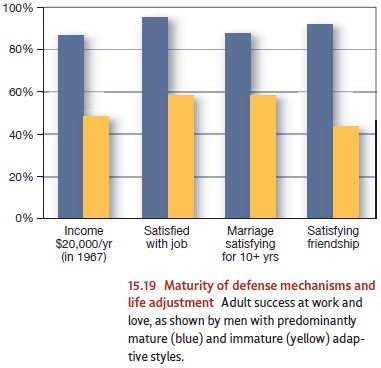Chapter: Psychology: Personality
Psychodynamic Approach: Psychodynamic Formulations after Freud

Psychodynamic Formulations after Freud
Plainly,
therefore, we need to be very careful about interpreting Freud’s claims—with
powerful challenges raised to both his central methods and his key concepts.
Even so, many scholars are convinced that Freud’s body of work contains a
number of important (some would say brilliant) insights, and so we might ask
how we can preserve these insights without endorsing the entire Freudian
conception. As it turns out, many schol-ars have tried to do this, producing a
welter of schools and camps, each offering its own extensions and elaborations
of Freud’s thinking.
EGO PSYCHOLOGY AND MECHANISMS OF DEFENSE
One
major theme among those who carried forward the torch of psychoanalytic theory
was that Freud had not sufficiently emphasized the skills and adaptive
capacities of the ego. Writers of this persuasion, loosely grouped under the
heading of ego psychology, sought to
extend and complete Freud’s theorizing.
The
various ego psychologists each have their own theoretical emphases, but all
agree with Freud’s contention that unconscious conflict is found in the well
adjusted as well as in people with disabling mental disorders. What is
essential for these more modern theorists, though, is how those conflicts can
be resolved in a fashion that is appropriate, pragmatic, and, ultimately,
healthy. Adherents of this position stress the positive aspects of the self as it
tries to cope with the world—to deal with reality as it is rather than to
distort it or hide from it. Seen in this light, the ego is not just an arbiter
between id and superego, but a clever strategist with intrinsic competencies
(A. Freud, 1946; Hartmann, 1964).
Building
on this perspective, investigators have explored how coping patterns evolve
over the course of the life span, and some of the data derive from longitudinal
studies covering a span of 20 to 30 years (J. Block & J. H. Block, 2006).
An example is George Vaillant’s analysis of the case reports of 94 male Harvard
College graduates studied at differ- ent points in their life span. They were
extensively interviewed at age 19, then again at 31, and yet again at 47.
Vaillant studied the predominant patterns of defense—that is, ways of
coping—each man used at these three ages. He classified the coping patterns
according to their level of psychological
maturity. At the bottom
of the hierarchy
were mecha- nisms that are often
found in early childhood and during serious men- tal disorder,
such as denial
or gross distortions
of external reality. Further up the ladder were patterns
often seen in adolescence and in disturbed adults, such as projection,
hypochondria, and irrational, emo- tional outbursts. Still higher were the
mechanisms studied by Freud andseen in many adults—repression, reaction
formation, and the like. At the top of the hierar- chy were coping patterns
that
Vaillant
considered healthy—such as humor, suppression (a conscious effort
to push anxiety-provoking thoughts
out of mind, at
least for the
time being, as opposed to repression, which is an unconscious process),
and altruism (in which one tries to give to others what one might wish to
receive oneself Vaillant’s findings indicated considerable continuity. Men with
more adaptive coping patterns at age
19 were more
likely to have
mature patterns in
their forties, and these patterns in turn predicted the results
on various objective indices that personality psy-chologists refer
to as life data, such as
satisfaction in marriage, rewarding friendships, gratifying jobs, and good
physical health (Figure 15.19). As is often the case, it is unclear whether the
mature coping defenses produced success in marriage and career or vice versa,
but it is worth knowing that the two tend to be correlated (Vaillant, 1974,
1976, 1977, 1994).

This
correlation was also observed in a study of 131 inner-city males interviewed in
junior high school and then surveyed 30 years later (G. E. Vaillant, Bond,
& Vaillant, 1986).
OBJECT RELATIONS AND ATTACHMENT THEORY
Yet
another development of Freud’s thinking comes from scholars who broadly
sup-ported Freud’s theorizing, but felt he had insufficiently emphasized the
real (as opposed to fantasized) relations an individual had with others.
Despite their many differences, these object
relations theorists held that relationships with important oth-ers, whom
they rather oddly referred to as “objects,” constitute a crucial and relatively
neglected motive underlying human behavior. Arguably, though, the object
relations theorist with the broadest and most enduring impact was John Bowlby
(1907–1990).
As
described, Bowlby was a British psychiatrist who believed people were motivated
by the desire for connection and closeness with others. In particular, Bowlby
believed that a child was powerfully shaped by her experiences with her primaryattachment figure (typically, but
not always, her mother) and emerged from childhood with a set of foundational
beliefs about both herself (as essentially good and lovable or not) and others
(as essentially good and loving or not). These mental representations of self
and other are referred to as internal
working models.
Bowlby
emphasized that different children develop different work-ing models, but it
was Mary Ainsworth (1913–1999) who created an experimental procedure designed
to probe these differences, and, specifically, to assess what type of
attachment a child had formed with his caregiver (Ainsworth, Blehar, Waters,
& Wall, 1978). As we dis-cussed, this Strange Situation test can be used to
cate-gorize children as securely attached,
anxious/avoidant in their attachment,
anxious/resistant, or disorganized in their attachment. These
attachment patterns, in turn, can then be used as predictors for a number of
subsequent measures—including the child’s personality in the next years, and
the quality of the child’s social relations.
Atttachment
theory has been a significant source of inspiration for researchers in
per-sonality, who have found that the attachment patterns established in early
childhood seem to have considerable staying power (Bartholomew & Horowitz,
1991; Brennan, Clark, & Shaver, 1998; Mikulincer & Shaver, 2007). For
example, Shaver and Clark (1994) found that compared to secure adults,
anxious/avoidant adults are less interested in romantic relationships and seem
less upset when the relationships end. In contrast, anxious/resistant adults
are highly focused on their relationships, and they fret and fume about them to
a much greater extent than secure individuals (Figure 15.20).

Does
all of this mean that one is simply out of luck if one has not developed the
“right” working model in childhood? Happily, the answer appears to be no.
Working models of self and other seem to be at least somewhat malleable and
context depend-ent, and new experiences (whether with friends, dating partners,
or a therapist) seem to have the power to refashion a person’s early ideas
about self and other. Even so, the ability to predict adult outcomes, based on
childhood patterns, does support at least one part of Freud’s
perspective—namely, the claim that the early years play a critical role in
shaping adult behaviors, expectations, and personality.
Related Topics